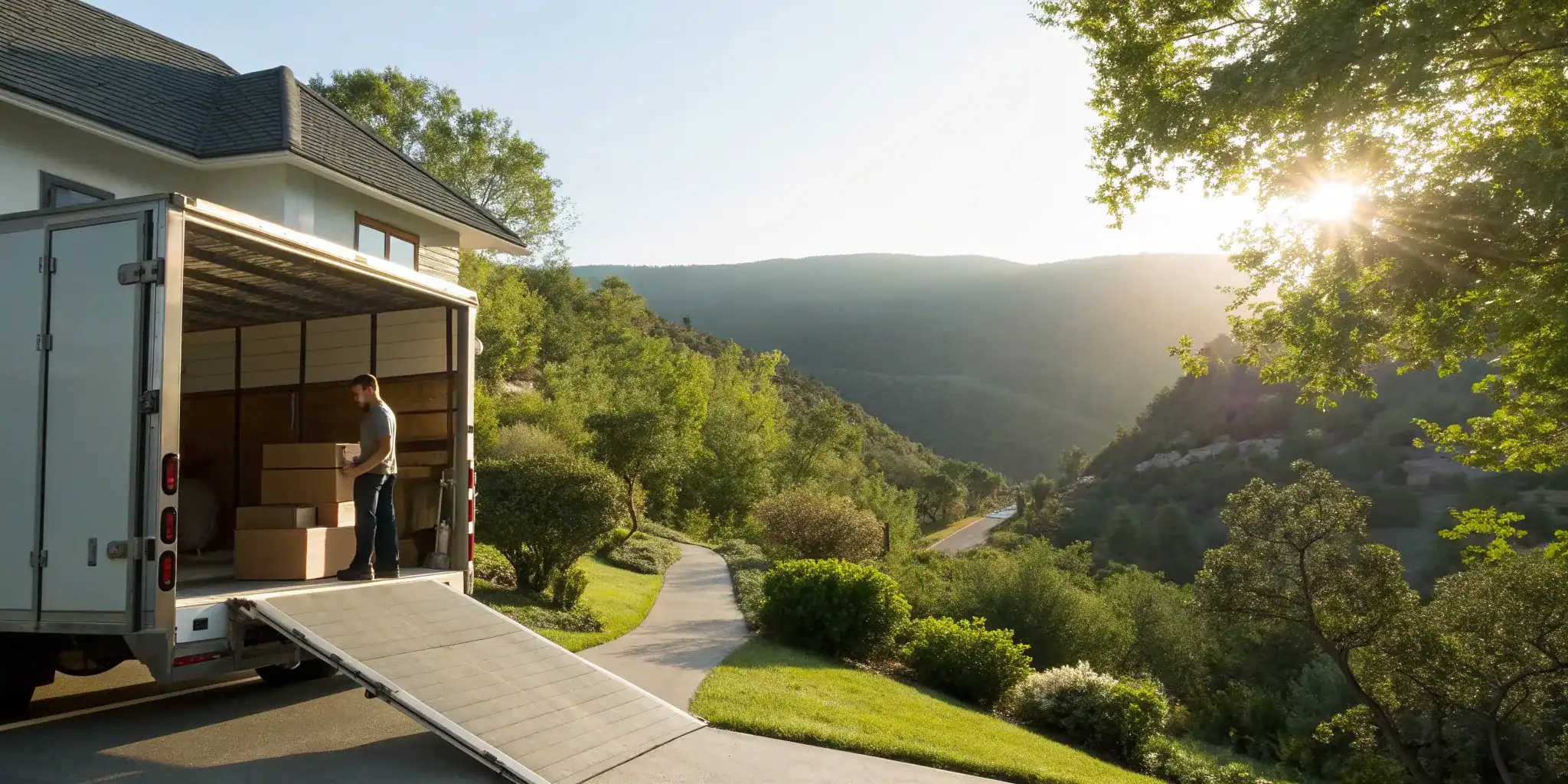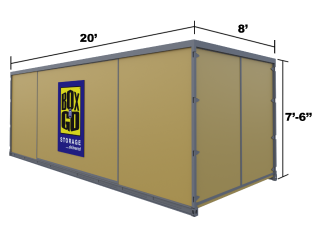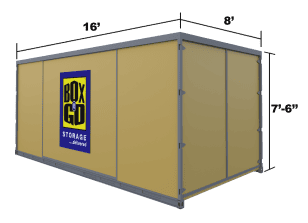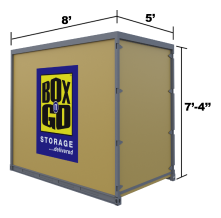Best Self Storage in Laguna Hills: Your Ultimate Guide

Let’s be honest: nobody looks forward to moving day. The thought of renting a huge truck, navigating tight corners, and hauling heavy furniture up a steep ramp is enough to make anyone procrastinate. For years, this was the only way to get your things into storage. You did all the work, twice. Thankfully, the industry has evolved. When you start looking for Laguna Hills self storage, you’ll find options that completely eliminate the need for a rental truck and cut your physical labor in half. This guide will compare the old way with a more modern, convenient approach, helping you understand the key differences so you can make a choice that truly simplifies your move and gives you back your weekend.
- Save 50% on move-in
- No truck rental
- Ground level










- Save 50% on move-in
- No truck rental
- Ground level
Box-n-Go Portable Storage Unit Sizes
Key Takeaways
- Choose a Method That Halves Your Workload: Don’t just compare monthly rates; compare the entire move-in process. Opting for a portable container delivered to your door eliminates the need for a rental truck and cuts the exhausting task of loading and unloading your belongings in half.
- Insist on Ground-Level Access and Solid Security: Make your move safer and easier by choosing a solution that avoids ramps, stairs, and elevators. Beyond convenience, confirm that any facility you consider has essential security measures like gated access and video surveillance to protect your items.
- Look Beyond the Sticker Price to Find the True Cost: The advertised monthly rate is just the starting point. To avoid surprises, always ask about one-time administrative fees, mandatory insurance requirements, and any available promotions to understand the total expense before you sign.

Your Guide to Self-Storage in Laguna Hills
Finding the right storage solution in Laguna Hills can feel like a huge task, but it doesn’t have to be. Whether you’re decluttering your home to create more space, managing an inheritance, or in the middle of a move, the need for extra room is a common part of life. But with so many options out there, it’s easy to get stuck trying to figure out what’s best. Do you need a small locker or a unit the size of a garage? Is it better to be close to home or closer to work? These questions can be overwhelming, but taking a moment to think through your specific situation will make the decision much clearer.
Breaking the process down into a few key steps is the secret to a stress-free experience. Before you start comparing prices or unit sizes, let’s walk through the basics of what you should consider to find the perfect fit for your belongings and your lifestyle. We’ll cover everything from the type of items you’re storing and the local climate to how location impacts your convenience. Getting clear on these points from the start will save you time, money, and a lot of hassle down the road. This guide will help you focus on what truly matters, so you can choose a storage option that works for you, not against you.
Define Your Storage Needs
First things first: take a quick inventory of what you plan to store. Are you clearing out a garage, storing items between moves, or looking for a long-term home for family heirlooms? The amount and type of stuff you have will determine the size of the unit you need. But beyond just the what, think about the how. The traditional process of renting a truck, loading it up, driving to a facility, and unloading everything is a major workout. A more modern approach is to have self storage units for rent brought directly to you. This way, you only have to load and unload your belongings once, which is a huge time and energy saver.
Consider the Local Climate
Laguna Hills enjoys a beautiful Mediterranean climate, but those warm, dry summers and mild, damp winters can affect your stored items. Temperature swings and humidity can be tough on sensitive belongings like wooden furniture, electronics, important documents, and artwork. For these types of items, you might want to look into climate-controlled storage options that maintain a consistent temperature and humidity level year-round. When you’re talking to different storage providers, be sure to ask what they do to protect items from the local climate, especially if you’re planning on storing things for more than a few months. It’s a small detail that can make a big difference in keeping your valuables in pristine condition.
Key Neighborhoods for Storage
Location is always a big factor when choosing a storage facility. You’ll find several options conveniently located throughout Laguna Hills, with many clustered near major roads like Moulton Parkway or close to the I-5 freeway for easy access. A central location is great if you plan on visiting your unit frequently. However, think about how much that physical location matters when the storage unit can come to you. Portable storage eliminates the need to drive back and forth to a facility. You can keep the container at your home for as long as you need, or have it picked up and stored in a secure warehouse, giving you flexibility that a fixed location just can’t match.
How to Compare Storage Facilities
Choosing a storage facility isn’t just about finding the cheapest rate; it’s about finding the right fit for your stuff and your sanity. The process of moving and storing your belongings can be a huge headache, but the right facility can make all the difference. When you start comparing your options in Laguna Hills, you’ll quickly see there are a few different models out there. Understanding how each one works will help you decide which is best for you, saving you time, money, and a whole lot of back pain.
Before you commit, think about the entire process, from packing that first box at your old place to retrieving it months later for your new one. You’ll want to consider convenience, accessibility, and security above all else. Let’s break down the main types of storage and the key features you should be looking for so you can make a choice you feel great about.
The Deal with Traditional Storage
You’re probably most familiar with traditional self-storage facilities. The process is pretty standard: you pack your car or a rental truck, drive everything over to the facility, and unload it all into your unit. These places often offer a wide variety of unit sizes, from small lockers to large garage-style spaces. Many also provide features like climate-controlled units to protect sensitive items like wooden furniture or electronics from temperature swings. While this model is common, it requires you to do all the heavy lifting—literally. You have to handle renting and driving a truck, then haul your items from the parking lot to your unit, which could be down a long hallway or even on an upper floor.
- Call or order online in minutes
- We deliver storage to you
- Pack at home, at your convinience
- Store on your property or at indoor facility
- Move locally or nationwide
- Call or order online in minutes
- We deliver 16′ and 20′ storage to you
- Pack at home, loading labor available
- Store on your property
- Secured Extra Space
A Smarter Way: Portable Storage
If the thought of renting a truck and loading it twice (once at home, once at the facility) already makes you tired, then portable storage is for you. With this approach, a company like Box-n-Go delivers a storage container directly to your home. You can take your time loading it right at your doorstep, on your own schedule. Once you’re done, we can pick it up and store it in our secure warehouse, or you can keep it on your property for easy access. This method completely eliminates the need for a rental truck and cuts your loading and unloading work in half. It’s a much more efficient and flexible way to handle your storage needs.
Why Ground-Level Access is a Game-Changer
Never underestimate the value of ground-level access. Lugging heavy furniture and endless boxes up steep ramps, into cramped elevators, or down long corridors is exhausting and increases the risk of dropping and damaging your belongings. Some traditional facilities offer drive-up units, which is a great feature to look for if you go that route. Portable storage takes this convenience a step further—the unit is always at ground level, just a few steps from your door. This makes loading and unloading significantly faster and easier on your body. When you need to access your items at our facility, your container is always available at the ground level, so you never have to worry about stairs or elevators.
What to Look for in Security
No matter which type of storage you choose, security should be a top priority. Your belongings are valuable, and you need peace of mind that they’re safe and sound. When you tour a facility or browse its website, look for essential security features. A secure facility should be clean, well-lit, and fully fenced. Key features include electronic gate access, which restricts who can enter the property, and 24/7 video surveillance cameras monitoring the premises. Don’t settle for anything less. A reputable company will be transparent about its security measures and proud to show you exactly how they protect your items.

20’ Container – all weather.
Perfect for 3-bedroom residence.
5-7 rooms, furniture, appliances, etc.

16’ Container – all weather.
Perfect for 2-bedroom residence.
3-5 rooms, furniture, appliances, etc.

8’ Container – all weather.
Modular – works for any need.
Each fits 1-1.5 rooms.
Find the Perfect Storage Unit Size
Choosing the right storage unit size can feel like a guessing game, but it doesn’t have to be. Picking a unit that’s too small means a frustrating game of Tetris you can’t win, while one that’s too big is a waste of money. The goal is to find that “just right” fit for your belongings and your budget. Think about what you’re planning to store—is it a few seasonal items, the contents of your apartment, or everything from your family home?
To make it easier, let’s walk through the common sizes and what they can typically hold. This will help you visualize your items in the space and choose a size with confidence. Remember, with a portable container, the right-sized unit is delivered directly to you, so you can start packing right at your doorstep without the hassle of a moving truck. It’s all about making your move simpler, and that starts with picking the perfect space for your stuff.
Small Units (For a few boxes or a small room)
If you’re looking to clear out a closet, store seasonal decor, or pack up a dorm room, a small unit is your best bet. These are perfect for those items that take up valuable space at home but you’re not ready to part with. Think of it as an extra walk-in closet. A small unit can comfortably hold several boxes, small furniture like a side table or a set of chairs, and miscellaneous items like sports equipment or files. It’s the ideal solution for decluttering your home without having to make tough decisions about what to keep.
Medium Units (For a one- or two-bedroom apartment)
This is one of the most popular sizes, and for good reason. A medium unit is typically large enough to hold the contents of a one- or two-bedroom apartment. It can accommodate larger furniture like a sofa, mattress, and dining set, plus major appliances and a good number of boxes. If you’re in between moves, renovating a couple of rooms, or just need to store the bulk of your apartment’s contents, this size offers the flexibility you need. To make packing easier, consider using a moving checklist to keep track of everything going into the unit.
Large Units (For an entire house)
Tackling a move from a larger home? A large storage unit is designed to handle it all. These spacious units can generally hold the furnishings from a two- to three-bedroom house, including bulky items from the living room, bedrooms, and dining room. You’ll have plenty of space for major appliances, garage items like tools and lawn equipment, and all those boxes you’ve packed. When you’re dealing with this much stuff, the convenience of loading a container at your own pace, right in your driveway, is a total game-changer. It simplifies a major part of the moving process.
Need to Store a Vehicle?
If you have a car, boat, or RV that needs a temporary home, you’ll likely need a specialized storage solution. While portable storage containers are perfect for household goods, vehicles have unique requirements and typically aren’t stored inside a container. Most traditional storage facilities offer dedicated outdoor or covered parking spots for this purpose. Before you store a vehicle, it’s a good idea to check with your local DMV for any specific regulations and learn how to properly prepare your car for long-term storage to keep it in great condition.
Must-Have Features to Look For
Once you have a general idea of the size you need, it’s time to think about the features that will make your storage experience better. Not all facilities offer the same perks, and the right amenities can save you time, protect your belongings, and make the entire process feel less like a chore. Think about what you’re storing and how you plan to use the unit. Are your items sensitive to temperature swings? How much heavy lifting are you willing to do?
Some features are about convenience, like having access to moving supplies on-site. Others are fundamental to protecting your things, such as climate control for delicate items. And for many, the most important feature is how easy it is to get your belongings into the unit in the first place. A ground-level unit that you can walk right into is a world away from hauling boxes up a ramp or into an elevator. We’ll walk through the most important features to consider so you can find a solution that truly fits your needs.
Do You Need Climate Control?
Climate control is one of those features you might not think you need until it’s too late. These units maintain a consistent temperature and humidity level, protecting your items from the extremes. While Laguna Hills has a beautiful climate, a standard storage unit can still get surprisingly hot. If you’re storing things like wooden furniture, electronics, artwork, or important documents, climate-controlled storage is a wise investment. It helps prevent warping, cracking, mold, and mildew. Many facilities, including Public Storage, offer this option, so be sure to ask if it’s right for the items you plan to store.
Easy Loading and Unloading
Think about the physical work involved in moving. With traditional storage, you often load a truck at your home, drive to the facility, and then unload everything again into the unit. It’s exhausting. A better approach is to find a solution that minimizes the heavy lifting. With Box-n-Go portable storage, you can load and unload directly into your unit at ground level, right outside your door. This simple change can reduce your handling time by 50% and save your back from hauling furniture up a narrow ramp. When comparing options, always ask about the loading process—it makes a huge difference.
Storage for Your Business
Storage units aren’t just for personal belongings. For many Laguna Hills entrepreneurs and small business owners, a storage unit is a flexible and affordable way to manage inventory, archive important documents, or store equipment without signing a long-term commercial lease. It’s a perfect solution for e-commerce businesses that have outgrown their garage or contractors who need a secure place for their tools. Many local facilities recognize this need and offer storage units for businesses in various sizes. If you’re running a business, look for a facility that offers convenient access hours and security features to protect your assets.
Access to Moving Supplies
There’s nothing more frustrating than being ready to pack and realizing you’re out of tape or don’t have the right size boxes. Choosing a storage provider that also offers moving supplies can be a huge time-saver. Many facilities keep essentials like boxes, packing tape, bubble wrap, and locks available for purchase on-site. This one-stop-shop approach means you won’t have to make an extra trip to the store when you’re in the middle of a move. It’s a small convenience that simplifies the logistics of packing and helps you get everything properly prepared for storage.
We deliver the best storage solutions. No gimmicks:
- No truck to rent. We deliver storage to you!
- Load/Unload only once.
- Pay only for space you use.
- Secure, climate-friendly facility.
- Drive-up access
No Truck to rent…EVER!
- Save money and time.
- Reduce the risk of accidents and injuries.
- No need to pay for gas, insurance & mileage!
Load ONCE Storage Solution!
- You only need to load your belongings once!
- No need to load and unload it all again into a storage unit.
- All containers come with easy ground level access!
Pay Only for the Space You Use!
(if storing at our facility)
- No not need to guess on how much space you actually need.
- Order an extra 8’ x 5’ unit. Do not use it – do not pay for it.
Secure, Climate-Friendly Facility!
- Highest degree of security and protection.
- Our 8’ x 5’ units are breatheable – no mold or mildew.
- No funky smell when your belongings return.
EASY Drive-Up Access!
(if storing at our facility)
- Access your units at ground level.
- No elevators, ramps, stairs to climb.
- Schedule access appointment & drive straight to your units.
Break Down the Costs and Fine Print
Figuring out the cost of a storage unit can feel like trying to solve a puzzle. The advertised monthly rate is just one piece. To see the full picture, you need to account for promotions, potential fees, and insurance requirements. A super-low price might look tempting, but it could come with surprise charges or strict terms that don’t fit your needs. On the other hand, a slightly higher rate might include valuable perks, like the convenience of a portable container delivered right to your door, which saves you from renting a truck and doing double the work.
Think of it this way: you’re not just renting space; you’re buying a service. The goal is to find a solution that fits your budget without adding stress to your move. Before you sign any rental agreement, it’s smart to ask for a complete breakdown of all costs. This includes the monthly rent, any one-time fees, and mandatory insurance. Getting all the details upfront helps you compare your options accurately and choose a storage facility that’s transparent and works for you, not against you.
What’s the Monthly Rate?
The monthly rate is the number you’ll see most prominently advertised, and it’s your starting point for budgeting. This price is almost always based on the size of the storage unit and any special features it has. For example, a small 5×5 unit will cost less than a large 10×20 unit, and a climate-controlled space will typically have a higher rate than a standard one. When you’re comparing facilities in Laguna Hills, make sure you’re looking at prices for the same size unit to get an accurate comparison. Call or check online to get a specific quote for the unit you need.
Look for Promotions and Discounts
Many storage companies offer great deals to attract new customers, and taking advantage of them can save you a lot of money, especially in the first few months. You’ll often see offers like the first month for $1 or a percentage off for a set period. For instance, Box-n-Go is currently offering a deal where you can get four months free when you rent a storage unit. These promotions can significantly lower your initial moving and storage costs. Don’t be shy about asking what specials are available—a simple question could lead to big savings.
Watch Out for Hidden Fees
The monthly rate isn’t always the final amount you’ll pay. It’s important to ask about any additional charges before you commit. Some facilities have a one-time administrative fee, which can be around $25-$30, just for setting up your account. You might also find fees for locks, late payments, or even for accessing your unit outside of standard hours. To avoid any surprises on your bill, ask for a full list of potential fees. A reputable company will be upfront about all costs, so you can budget accurately and confidently.
Know the Insurance Rules
Your belongings are worth protecting, and most storage facilities will require you to have insurance. Before you purchase a policy from the storage company, check your existing homeowner’s or renter’s insurance. Many policies already cover personal property stored off-site, which could save you from paying for duplicate coverage. If your policy doesn’t cover it, or if you need to purchase a separate plan, the facility can usually offer you one. Having the right insurance provides peace of mind knowing your valuables are protected while they’re out of your hands.
How to Make Your Final Decision
You’ve narrowed down your options, and now it’s time to choose the right storage solution. Before you commit, a few final checks can ensure you’re making a choice that fits your life, not one that creates more work. Think of this as your final walkthrough. Taking a few extra minutes to confirm these details will give you peace of mind and save you from any frustrating surprises down the road. From understanding the fine print to picturing your actual move-in day, here’s what to look at before you sign.
Check the Location and Access
For a traditional storage facility, location is everything. You’ll be the one driving back and forth, so a convenient spot is non-negotiable. A facility right off a major freeway might seem great, but think about your actual route. Is it easy to get in and out of? Now, consider an alternative: what if the storage unit came directly to you? With portable storage containers, the “location” is your own driveway. You get unbeatable access right outside your door, skipping the hassle of driving a moving truck to a locker in a maze-like building.
Confirm the Operating Hours
Imagine needing to grab something from your unit after work, only to find the gates are locked. Many traditional facilities have restricted access hours, often closing as early as 6 or 7 p.m. and limiting weekend availability. Always ask for the specific “gate hours,” as they can be different from the office hours. This is another area where having a container on your own property shines, offering you 24/7 access without question. If your container is at a central warehouse, confirm their access policy.
Read the Rental Agreement Carefully
I know, reading contracts is nobody’s idea of fun, but this step is crucial. Most facilities offer flexible month-to-month leases, but the devil is in the details. Look for any hidden costs, like a one-time “administrative fee” that can be tacked on when you sign up. What are the rules for moving out? Do you need to give 30 days’ notice? Understanding the terms of your agreement prevents future headaches and ensures you know exactly what you’re paying for.
What’s the Move-In Process Like?
This might be the most important factor. Picture the day you move your belongings into storage. With a traditional unit, you have to load a truck at your home, drive it to the facility, unload everything onto carts, navigate hallways and elevators, and then return the truck on a tight schedule. A more streamlined approach completely changes the experience. With a portable container, the unit is delivered to you. You can load it at your own pace, on your own schedule. There’s no truck to rent and no loading your items twice.
Smart Tips for a Stress-Free Move-In
Moving day doesn’t have to be a chaotic scramble. With a bit of forethought, you can turn a stressful process into a smooth, organized transition. It all comes down to how you pack and arrange your storage unit. A smart plan not only saves you time and energy but also protects your belongings and makes it easy to find what you need later. Think of your storage unit as an extension of your home—a space that works for you, not against you. Whether you’re storing a few boxes or the contents of your entire house, these simple strategies will help you get it right from the start, so you can focus on settling into your new space.
Maximize Your Storage Space
The key to getting the most out of your unit is to think vertically. Stack sturdy, same-sized boxes to create stable columns, placing the heaviest ones on the bottom. Disassemble furniture like bed frames and tables to save precious floor space. With Box-n-Go, our portable storage containers are delivered right to you, which cuts your handling time in half since you only load once. Because our units are modular, you can rent just the amount of space you actually need, instead of paying for a half-empty room. This approach ensures every square inch is used effectively, saving you money and hassle.
Organize Your Unit Like a Pro
A well-organized unit is a lifesaver when you need to find something specific. Before you start loading, create a clear pathway down the middle so you can reach items in the back. Label every box on multiple sides with its contents and the room it belongs to. For an extra level of organization, keep a running inventory on your phone. Most importantly, place items you’ll need to access soon—like important documents or seasonal gear—right at the front of the unit. This simple step will save you from having to unpack everything just to find one specific thing. A little strategic packing makes all the difference.
Protect Your Valuables
Keeping your belongings safe involves two things: smart packing and choosing a secure facility. Wrap fragile items in bubble wrap or packing paper, and use furniture pads or blankets to prevent scratches on wood surfaces. Distribute weight evenly in boxes and never place heavy items on top of delicate ones. When you’re choosing a facility, look for essential security features like good lighting, gated access, and video surveillance. At Box-n-Go, once you’ve packed your container, we pick it up and store it inside our secure, access-controlled warehouse, giving you peace of mind that your valuables are protected around the clock.
Plan for Seasonal Storage
If you’re storing items for the long haul, think about the changing seasons. Storing holiday decorations, winter coats, or summer sports equipment is a great way to free up closet space at home. When you pack, group these seasonal items together so you can easily swap them out when the time comes. It’s also important to consider the local climate. Items like wooden furniture, electronics, and photographs can be sensitive to temperature swings. Using a climate-controlled storage option protects your belongings from damage caused by heat and humidity, which is a smart move for anything you plan to keep for more than a few months.
Related Articles
Frequently Asked Questions
What’s the main advantage of a portable container over a regular storage unit? The biggest difference is the amount of work you have to do. With a traditional storage unit, you’re responsible for renting a truck, loading it at your house, driving to the facility, and then unloading everything again into your unit. A portable container eliminates the truck rental and the double-handling. The unit is brought to you, so you only have to load your belongings once, right at your doorstep. It cuts the physical labor in half and saves you a ton of time and stress.
I’m worried about picking the wrong size unit. Any advice? It’s a common concern, but you can get a great estimate by thinking in terms of rooms. A small unit is perfect for the contents of a large closet or a dorm room. A medium unit can typically handle a one or two-bedroom apartment. If you’re moving out of a larger house, you’ll want a large unit. The best approach is to make a quick list of your largest items—like your sofa, mattress, and major appliances—and use that as your guide when talking to the storage company. They can help you visualize the space and find the perfect fit.
Is climate control really necessary for my stuff in Laguna Hills? While our weather is generally mild, a standard garage or storage unit can still get quite hot, and that can be tough on certain items over time. If you’re storing things that are sensitive to temperature or humidity—like wooden furniture, electronics, artwork, or important papers—then climate control is a very smart move. It helps prevent issues like warping, cracking, and mildew, ensuring your valuables stay in the same condition you left them.
How does the process work if I have a storage container delivered to my home? It’s incredibly straightforward. You schedule a delivery, and a container is brought right to your home and placed in your driveway or another convenient spot. You can then take as much time as you need to load it on your own schedule. Once you’re finished, you just call the company to have it picked up. From there, it can be moved to your new home or transported to a secure warehouse for storage.
Besides the monthly rent, what other costs should I be prepared for? It’s wise to ask about the total cost before you sign anything. Some facilities charge a one-time administrative or setup fee. You will also likely be required to have insurance for your belongings, which can either be covered by your existing homeowner’s or renter’s policy or purchased directly from the storage company. Always ask for a clear breakdown of all potential charges so there are no surprises on your first bill.


